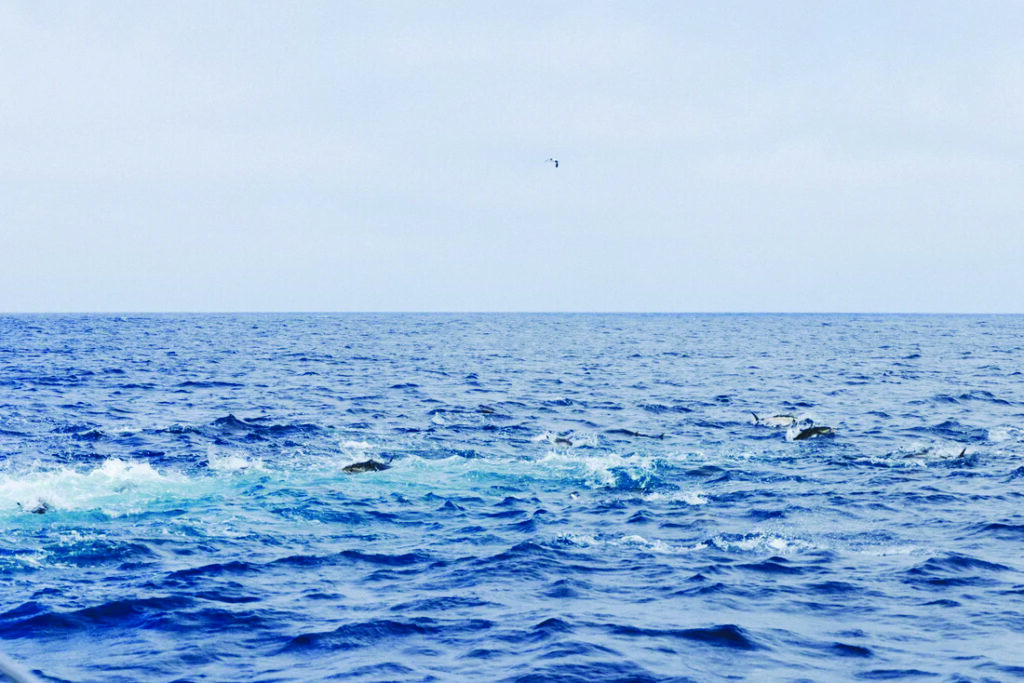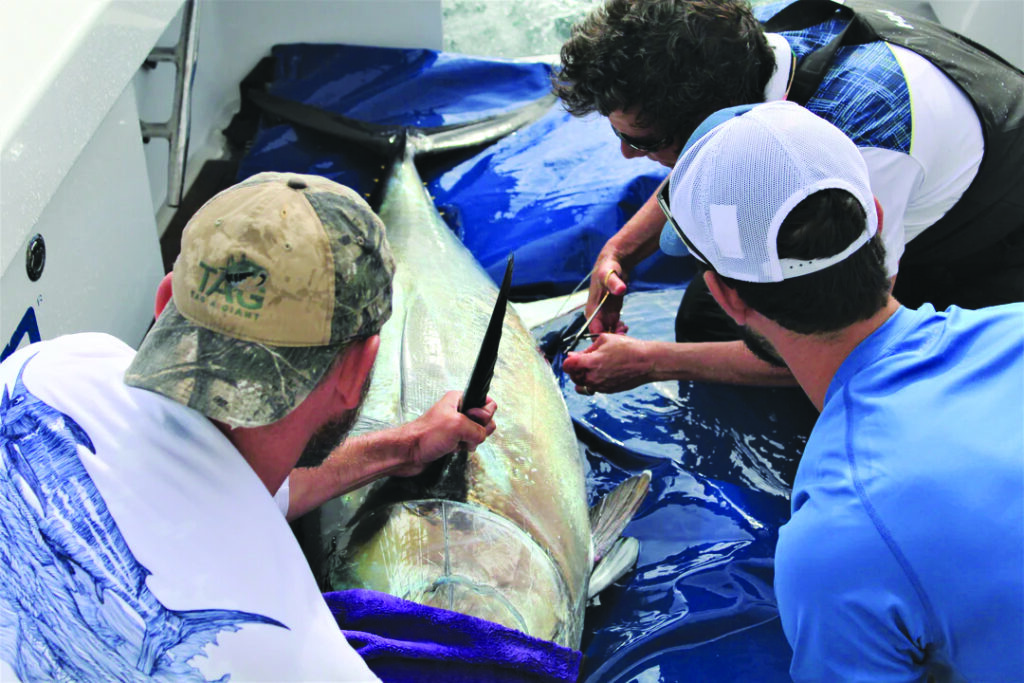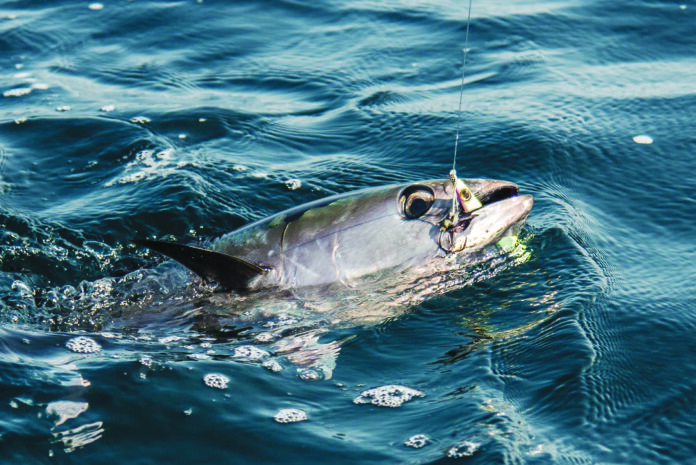
BY JOHN BROWNLEE and AFTCO staff
Sportfishing community leaders unite to help ensure the Pacific bluefin resource stays healthy and anglers continue to have access to it
In 2012, the population of Pacific bluefin in the eastern Pacific reached a low point from overfishing by the commercial purse seine fishery. From there, the quotas were lowered, and by 2016, the Pacific bluefin population began to recover faster than expected. Unfortunately, purse seine quotas are rapidly increasing, drawing concern from community sportfishing leaders, including CCA Cal, CCA National, ASA, IGFA, Wild Oceans, NNMA, and the Center for Sportfish Policy.
The Return of Pacific Bluefin
The Pacific bluefin has always been a mysterious species. Once found off the coast of Southern California in the 1950s, it disappeared and was rarely seen for decades. Then, suddenly, in 2016, it was back in Southern California.
“For most of my angling life in Southern California, larger Pacific bluefin tuna were nonexistent in our waters,” said Bill Shedd, CEO of the American Fishing Tackle Company (AFTCO). “But then, in 2016, the fish suddenly reappeared in incredible numbers. It was unbelievable. A reliable fishery was established almost overnight, bringing a tremendous economic boom to this area.”
Shedd said that the Inter-American Tropical Tuna Commission (IATTC), an international treaty organization that manages Pacific bluefin, started lowering commercial quotas in 2012. As a result, this once-overfished population rose to almost 22% of its potential unfished level. This goal wasn’t expected to come to fruition until 2022. A similar situation happened in Florida, where longlines were removed from most South Atlantic Bight, allowing swordfish stock populations to recover and creating a recreational economic spending stimulus.
With management practices in place following the depletion of the stock over generations, Dr. Bruce Pohlot, Director of Conservation for the International Game Fish Association (IGFA), said, “The positive outcome of recent stock assessments in 2022 and 2024 for Pacific bluefin is reassuring and suggests that the stock is recovering, although spawning stock biomass (SSB) remains at a very low percentage of unfished levels,” Pohlot said. “Because SSB is a small percentage of unfished biomass, any increases to catch limits should be treated with caution to maintain and further rebuild this ecologically and economically important stock for the long-term benefit of both commercial and recreational fisheries.”
The Threat of Increasing Quotas – Domestic & International
“One does not need to live in California to know what a huge impact the return of large bluefin tuna to California waters has had on the sportfishing and boating community, in California and beyond,” Shedd said. “Today, sportfishing in California for Pacific bluefin is the best it has been in anyone’s memory, benefitting both our industry and anglers.”
IATTC, with the NOAA, recently increased the US commercial Pacific bluefin quota by almost 80%. In 2023-2024, the Pacific bluefin quota was 1,017 metric tons (mt); for 2025-2026, it’s up to 1,822 mt. Another primary concern stems from the Mexican commercial bluefin quota for their purse seine fleet. These commercial fisheries catch the bluefin before they reach US waters, and their quota rose from 6,973 mt in 2023-2024 to 10,763 mt in 2025-2026.
“We have concerns that as the numbers grow, we will see increased allowances for commercial fisheries across the North Pacific,” Pohlot said. “We want to make sure any increases in catch are done with a very precautionary approach as we never want to let this stock decline again. There are also concerns that management may be using incorrect age of maturity estimates, which would profoundly impact assessment results and potential management actions.”
The current Pacific bluefin conservation measures are developed by consensus based on science produced by the seven-country International Science Committee for Tuna and Tuna-Like Species in the North Pacific Ocean. This group also included NOAA fishery scientists, who believe Pacific bluefin spawn between the ages of three and five. Knowing the spawning age is critical because the younger a fish spawns, the more its population is available for harvest. However, the exact spawning age has not been confirmed yet.
Internationally, Japan controls the science and allocation situation, that primarily benefits the Japanese and commercial fleets. Pacific bluefin species management is a complicated issue on a domestic and international scale that will require involvement by all the relevant recreational fishing organizations.
More Accurate Data & Science Needed
Pacific bluefin spawn in the Sea of Japan. At about one year, some of the spawn heads east and crosses the Pacific to feed in waters off Baja, California. They then begin an annual figure eight pattern that takes them north to Monterey, California, and back down to Baja until they reach spawning age. Then, they head west back across the Pacific to spawn in Japan.
The exact spawning age of Pacific bluefin hasn’t been confirmed. With support from sportfishing anglers, boats, and tag funding, Dr. Barbara Block has satellite-tagged larger Pacific bluefin to learn when they cross the Pacific to spawn. After years of studying tagging data from bluefin in the Atlantic, Dr. Barbara Block has gathered and received preliminary data showing that Atlantic bluefin spawn when they’re six to eight years old, not when they’re three to five. There is still a lot to learn, but this discovery is a prime example of why NOAA fisheries should consider funding additional tags and acknowledge the importance of this work to understand the actual Pacific bluefin spawning age.
The Importance of Recreational Input
“The sport-fishing community must demand participation in the decision-making and management of Pacific bluefin,” Shedd said. “If we don’t do so, I am concerned that overfishing by foreign commercial interests will once again crash our bluefin fishery. We rely on NOAA Fisheries to speak for our interests, with no real input or push from us. That is problematic at best. Further complicating the future of Pacific bluefin is that the current management process relies on outdated and inaccurate science developed by Japan that fits the self-interest of their commercial fleets.”
Shedd says there are two basic things we can do to help prevent a future Pacific bluefin population crash. “First, we need to register our concern for the growing Mexican and American commercial quotas within IATTC,” he said. “And second, we need to better understand the actual spawning age of Pacific bluefin.” Research to determine a more accurate spawning age range for the bluefin will continue with Dr. Block and others. It will hopefully lead to a more accurate data set and better science outcomes for managers.

Recommendations for Management
“The IGFA recommends the Commissions (WCPFC and IATTC) take the following steps to protect Pacific bluefin stocks,” Pohlot said. “They should take a precautionary approach to potential increases in catch limits by not significantly increasing those limits and ensure rebuilding targets continue to be met in the coming years. They must also continue to monitor Pacific bluefin spawning stocks and recruitment to ensure model assumptions are validated moving forward and ensure that catch overages do not occur by urging nations to implement domestic catch limitation measures. And they should reevaluate age at maturity parameters for Pacific bluefin and explore available science to determine accurate age at maturity, similar to Atlantic bluefin tuna, as we believe that most fish caught are juveniles that have not had a chance to spawn.”
Through more accurate data from satellite tagging and recreational input from sportfishing anglers, the return of the Pacific bluefin does not have to be short-lived. Instead, it can be long-lasting, with key advocates like Bill Shedd and Dr. Bruce Pohlot staying vigilant and speaking out to ensure change happens.
To learn more about the resurgence of Pacific bluefin, check out the scientific tuna tagging blog, the Year of the Bluefin film, or the bluefin species spotlight to discover more about this magnificent species and how to continue protecting them. Read the entire Pacific Bluefin piece by John Brownlee on In The Bite.



